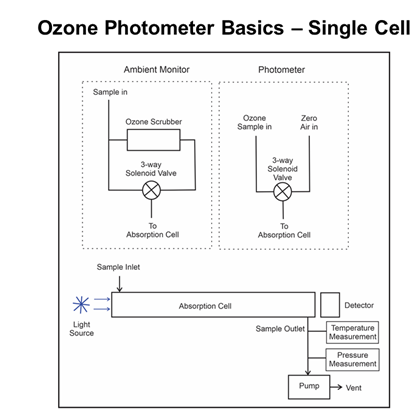Better science for more accurate measurements of ground-level ozone
Preparing for a Change in the Way that Ozone is known.
The way that ozone, a gas in the Earth’s atmosphere, is measured at ground level by the scientific community is changing. Ozone at ground level is considered a pollutant that is harmful to human health, so it is measured by industries, government regulators, community air quality managers, and others.
This site contains information for atmospheric scientists, instrument manufacturers, quality managers, modelers, and other communities who measure ozone at ground level and who are concerned about ozone as a pollutant.
What is changing?
Scientists recalculated a physical constant using a large amount of scientific data from 1959 to the present day. The physical constant is part of the equation used to calculate the amount of ozone that is measured using instruments sometimes called photometers. Photometers work by measuring the amount of light absorbed by Ozone in a cell containing a sample of air. Ozone absorbs UV light at a wavelength of 254 nanometers. UV light is sent through the absorption cell. The intensity of UV light measured by a detector at the other end of the cell is used to calculate the Ozone concentration (for further details see Ozone Photometer Basics).
Why does this matter?
- Better measurements will result in more efforts toward cleaner air which is better for human and environmental health.
- The new physical constant is better known, and it means that ozone can be measured more accurately.
- The new method will result in properly calibrated instruments.
When will the change take place?
- The implementation start date is January 2025 and the implementation completion date is January 2026.
- At that time, the ozone scientific and measuring community will formally adopt the change.
What should you do?
- Sign up now to be alerted when more information about the change is available.
- Look at our available resources:
- Hodges et al. 2019
- 2020 BIPM workshop “Accurate Monitoring of Surface Ozone”
- Statement with intention to change the ozone absorption cross-section
- Units and values for the ozone absorption cross section at 253.65 nm (air) with appropriate significant digits and rounding for use in documentary standards
Ozone Photometer Basics
A photometric instrument performs a calculation using the UV detector signals, ambient temperature, pressure, the absorption cell length, and the absorption cross section value to calculate the final ozone concentrations using the Beer-Lambert law.
Photometers, like NIST Standard Reference Photometers, work by passing UV light through an absorption cell containing a sample of the air within it. Some of the light will be absorbed by ozone, and a UV detector measures the intensity of light after it has passed through the air/ozone sample. Light energy at a wavelength of 253.65 nm is absorbed by ozone. In an ambient analyzer, the intensity of light detected in an absorption cell with air but without ozone is compared to the intensity of light detected in an absorption cell with a sample of air from the environment. In a photometer used for calibration, the air comes from a zero-air generator, and ozonated air is produced from that same zero-air. In very simple terms, the difference provides a measurement of the concentration of ozone in the sampled air. To arrive at that measurement, you must use a mathematical constant for the ability of a molecule of ozone to absorb a photon of light at 253.65 nm wavelength. This is known as the absorption cross section value. For further information see the following link.

